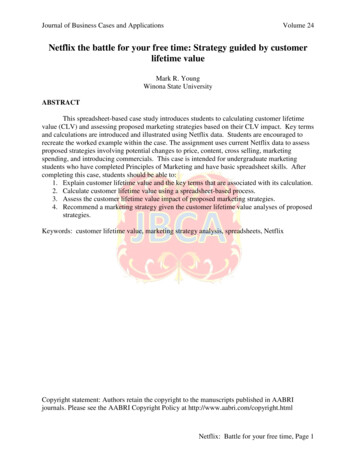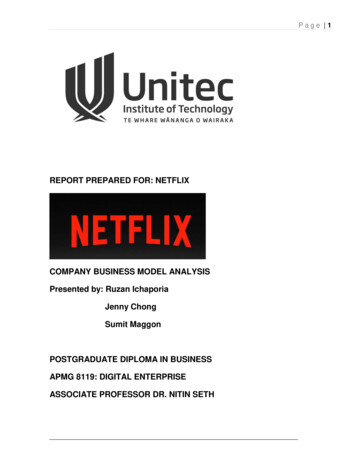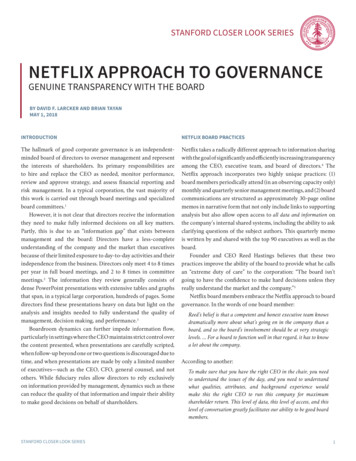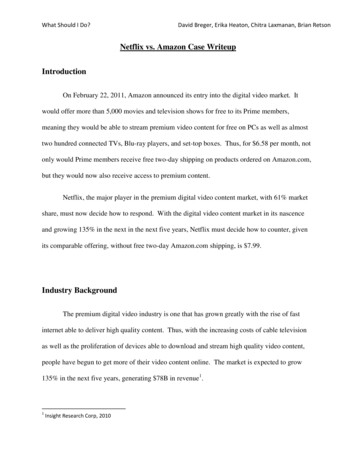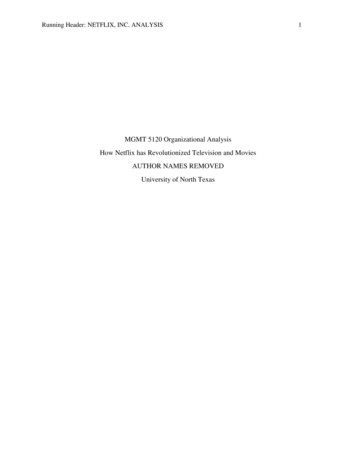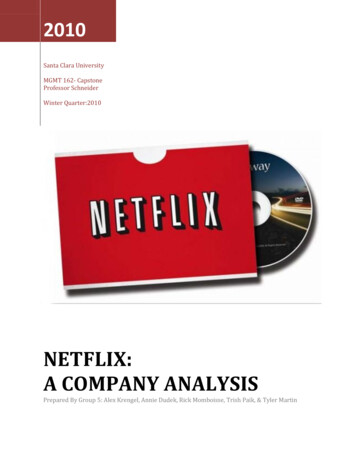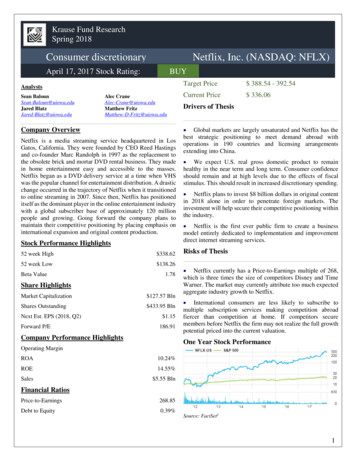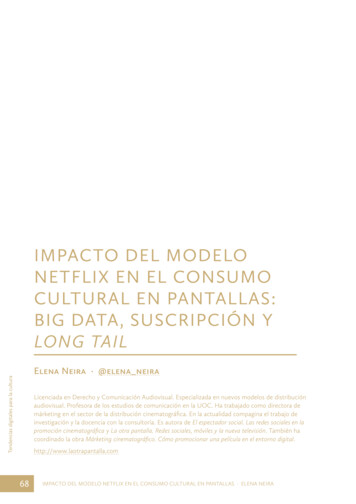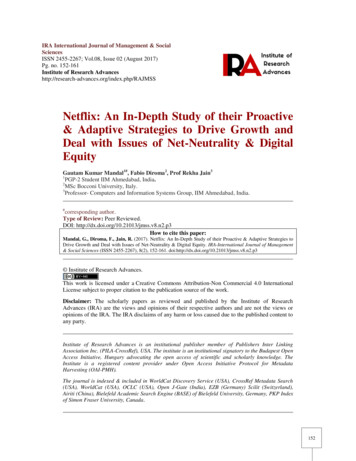
Transcription
IRA International Journal of Management & SocialSciencesISSN 2455-2267; Vol.08, Issue 02 (August 2017)Pg. no. 152-161Institute of Research MSSNetflix: An In-Depth Study of their Proactive& Adaptive Strategies to Drive Growth andDeal with Issues of Net-Neutrality & DigitalEquityGautam Kumar Mandal1#, Fabio Diroma2, Prof Rekha Jain31PGP-2 Student IIM Ahmedabad, India.2MSc Bocconi University, Italy.3Professor- Computers and Information Systems Group, IIM Ahmedabad, India.#corresponding author.Type of Review: Peer Reviewed.DOI: http://dx.doi.org/10.21013/jmss.v8.n2.p3How to cite this paper:Mandal, G., Diroma, F., Jain, R. (2017). Netflix: An In-Depth Study of their Proactive & Adaptive Strategies toDrive Growth and Deal with Issues of Net-Neutrality & Digital Equity. IRA-International Journal of Management& Social Sciences (ISSN 2455-2267), 8(2), 152-161. doi:http://dx.doi.org/10.21013/jmss.v8.n2.p3 Institute of Research Advances.This work is licensed under a Creative Commons Attribution-Non Commercial 4.0 InternationalLicense subject to proper citation to the publication source of the work.Disclaimer: The scholarly papers as reviewed and published by the Institute of ResearchAdvances (IRA) are the views and opinions of their respective authors and are not the views oropinions of the IRA. The IRA disclaims of any harm or loss caused due to the published content toany party.Institute of Research Advances is an institutional publisher member of Publishers Inter LinkingAssociation Inc. (PILA-CrossRef), USA. The institute is an institutional signatory to the Budapest OpenAccess Initiative, Hungary advocating the open access of scientific and scholarly knowledge. TheInstitute is a registered content provider under Open Access Initiative Protocol for MetadataHarvesting (OAI-PMH).The journal is indexed & included in WorldCat Discovery Service (USA), CrossRef Metadata Search(USA), WorldCat (USA), OCLC (USA), Open J-Gate (India), EZB (Germany) Scilit (Switzerland),Airiti (China), Bielefeld Academic Search Engine (BASE) of Bielefeld University, Germany, PKP Indexof Simon Fraser University, Canada.152
IRA-International Journal of Management & Social SciencesABSTRACTNetflix has been on the rise since its beginning in 1997, when one sees it from a distantperspective. However, a close analysis of its unique strategies shows that the company facedseveral small and big challenges in its growth journey, some of which, had the potential tothrow the company away permanently from the market itself. Nevertheless, it respondedtactically to all such issues, many of them being dealt in preventive and pro-active manner;while other cases being dealt with quick reactions, essentially faster than any othercompetitors. This report is a study of many such issues that the company faced, since itsbeginning till recently, when it almost conquered the whole world, after establishing its feet inChina as well, in collaboration with the service provider Baidu. The report also entails someunique strategies that the company followed while continuously and marginally changing itsbusiness model, which would seldom be possible in a brick-mortar economy. As such, thecompany made use of its deeper understanding of how markets react in an internet economy.Effort has been made to throw some light on the way the company has dealt the issues ofdigital discrimination allegations against it, and also its stance on net neutrality. Finally,some of the challenges and opportunities that the company has encountered recently,including the lawsuits has been touched upon, presenting the company’s as well as outsidermedia’s view on those, and has been concluded with potential problems and future aspects.Keywords: Streaming media, video-on-demand, digital discrimination, net neutrality,proactive strategies, NetflixMethodology Used & Source of Data: Secondary research (literature, articles, company official press notes,company public speeches & videos), Primary research (survey sent to 200 global participants, expertinterviews), Annual Reports, Qualitative analysis frameworks for understanding intangible losses.Netflix as an Entertainment CompanyNetflix started as an entertainment company in the US and it specializes in providing streaming media andvideo-on-demand online and DVD by mail. But has its growth means and rate been like any other so-calleddisruptive firm? Certainly not. As per the company reports of July 2017, Netflix currently has103.95 millionsubscribers worldwide, including 51.92 million in the United States itself.[1] However, it is worth mentioningthat the company never had a single point mantra for its growth. The growth of Netflix with respect to its primebusiness model & the method of customer acquisition has varied substantially over the time period from 1997 to2017. It has been a highly agile and pro-active company not only in its growth front, but also in dealing with thecriticism it has faced time to time.Netflix was founded by Reed Hastings and Marc Randolph on August, 1997, in Scotts Valley, California.Currently, it has its headquarters in Los Gatos, California. The core business has been media streaming and ondemand videos, but, in 2013, Netflix ventured into television and film production, along with onlinedistribution. [2]Brief Summary of Netflix’s business model& its expansion: The initial business model included DVD salesand rental, although Hastings jettisoned DVD sales about a year after Netflix's founding to focus on the DVDrental by mail business. ([3] Keating, Gina, 2012 “Netflixed: The Epic Battle for America's Eyeballs” NewYork: Penguin. p. 47.). Thenceforth, in parallel with its consolidated rental service of Blu-ray and DVD, thecompany expanded its spectrum of business areas introducing media streaming,Next step followed was expanding internationally; with streaming made available to Canada in 2010 ("Netflixlaunches Canadian movie service". Canadian Broadcasting Corporation Report 2011[4]). It continued growingits streaming service to other countries and by January 2016, Netflix services operated in over 190 countries(Wall Street Journal, "Netflix Expands to 190 Countries", Amol Sharma, EzequeilMinaya[5])In the table below, we have chronologically summarised the international expansion of Netflix, which has auser interface of over 20 languages now. It has been built from data collected from CBS Interactive Report,2016, “Netflix goes live in 130 new countries” and few other sources for individual countries [6].Please see thetable next page.153
IRA-International Journal of Management & Social x starts its online streaming operation in the USNetflix start its expansion abroad, by taking off broadcasting operation in in CanadaThe service is expanded in the Latin American and Caribbean Island marketNetflix service lands over the sea, January 4 its time for the English speaking market of United Kingdomand Ireland. In September of the same here, the Scandinavian countries are targetedThe company gradually slows down expansion due to raising costs. The only new country where itbecomes available is The NetherlandsNetflix is in France, Austria, Belgium, Germany, Luxembourg, and Switzerland.Netflix pushes its operations worldwide, by adding to Australia, New Zealand, Japan, Italy, Portugal,and Spain.Only 6 years after crossing the American borders, Netflix announces at Consumer Electronics Show thatis serving everywhere in the world apart from China, Syria and Crimea.In April 2017, Netflix manage to reach a deal to broadcast also in China: they will be in partnership witha local streaming platform, iQiYi, owned by the technological giant Baidu. In a quick escalation, Netflixhas been able to serve customers all over the world.Table: Chronological International expansion of NetflixIn the meantime, Netflix entered the content-production industry in 2013, debuting its first series, House ofCards in February, 2013. As per the report of USA today, “Netflix chief bulks up on series (600 hours!)” in2016,It has since then greatly expanded the production of both film and television series and had started offeringa new value proposition, called “Netflix Original” content, with the help of its online library of films and TV.[7]The extent of expansion that Netflix has undergone today can be judged from the fact that Netflix had released126 original series or films in 2016, while no other channel or media remained close to it, and is aiming towardsa content monopoly.Net Neutrality and NetflixWe shall first understand the contemporary idea of net neutrality, and then analyse the same in the context ofNetflix. When we go online we have certain expectations. We expect to be connected to whatever website youwant. We expect that our cable or phone company isn‟t messing with the data and is connecting we to allwebsites, applications and content you choose. In essence, we expect to be in control of our desired internetexperience.This expectation gives rise to the core concept of net neutrality. Net Neutrality is the basic principle thatprohibits internet service providers like AT&T, Comcast and Verizon from speeding up, slowing down orblocking any content, applications or websites you want to use. Similarly, for firms like Netflix, they should notbe throttling or speeding up contents, prohibiting contents from any segment- this is what builds the idea of netneutrality. As such, net neutrality is the way that the internet has traditionally worked.In the context of Netflix as well, the Netflix debate holds a lot of relevance. In fact, the firm must maintain acredible reputation in such debated matters for its sustained acceptance across a wide customer base. In 2015,millions of activists pressured the Federal Communications Commission (FCC) to adopt historic Net Neutralityrules that keep the internet free and open. This would allow one to share and access information of oneschoosing without interference. Let us analyse how the situation has changed over time, and how has Netflixresponded to the same. Netflix has tried to maintain a popular image all this while (based on the primaryresearch findings which concluded that the number of internal meetings and communication inside the companyregarding net neutrality related initiatives, increased by over 300% in the last 3 years).However, the previous win of the activists of net neutrality is now under jeopardy. As per the July 12, 2017issue of „The Guardian‟ it is evident that Trump‟s FCC chairman, AjitPai, wants to destroy Net Neutrality. He isagainst open internet, and unfortunately, on May 18, the FCC voted to let Pai‟s internet-killing plan moveforward. Now the compliance requirement may have become easier for the competing firms, but for a reputedcompany like Netflix, changing their strategies must examine other repercussions also; and it may just not bepossible for them to give a hint of discrimination to the customers right away.154
IRA-International Journal of Management & Social SciencesMany experts of the sector are of the opinion that Internet Standard Providers should try to democratize as muchas possible network access, instead of obstructing or openly discriminating against the content streamed overthose networks. After February 2015, enaction of Title II legal foundation strengthened this pressure This meantthat even though there may be a better way of market segmentation and targeting the customers for Netflix, theycould not simply do it so as to comply with net neutrality rules.To quote Google Chairman Eric Schmidt, he has aligned Google's views, which is now a popular view, on datadiscrimination with Verizon‟s views as follows: “I want to be clear what we mean by Net neutrality: What wemean is if you have one data type like video, you don't discriminate against one person's video in favor ofanother. But it's okay to discriminate across different types. So you could prioritize voice over video. And thereis general agreement with Verizon and Google on that issue.” It is clear that discrimination between data typesshould not be a major issue with companies like Netflix, but they must take care within data type i.e. video intheir case.[8]Research tells that a mixture of policy instruments will help realize the range of valued political and economicobjectives central to the network neutrality debate. (Bauer, Johannes; Obar, Jonathan A. (2014). "Reconcilingpolitical and economic goals in the net neutrality debate". Information Policy. 30 (1): 1–19.[9]) Combined withstrong public opinion, this has led some governments to regulate content and online media providing firms,similar to the way electricity, gas and water supply is regulated. Now that Netflix exists in 190 countries, theymust create a different business plan for all of them depending on government regulation which if not managedproperly, is a major challenge.Netflix Content StrategyAs mentioned earlier, Netflix has either been pro-active or highly reactive in their approach to share content. AnApril 2017 article of Forbes analyses its content strategy with intriguing parameters such as originality, trend &audience identification. As a matter of fact, Netflix‟s results of 2017 have been highly supernormal. But therehas been some disparity in the domestic and the international performance, which may be due to their contentstrategy.In the international subscribers‟ market, the firm has continued its strong run with significant growth. However,in the domestic subscriber market, the company‟s growth has been slowing down, mainly due to intensifiedcompetition in the streaming segment. Essentially, the differentiators in the content sharing strategy were less innumber and novelty in the domestic market. The company was still able to add around 1.5 million domesticsubscribers in the first quarter. (Forbes 2017, “A closer look at Netflix‟s content strategy[10]).Competi
Netflix started as an entertainment company in the US and it specializes in providing streaming media and video-on-demand online and DVD by mail. But has its growth means and rate been like any other so-called disruptive firm? Certainly not. As per the company



